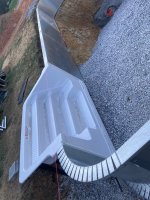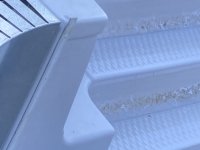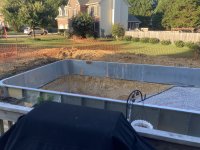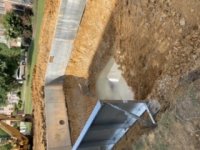Hi everyone. DIY build on an 18x36 metal wall Latham pool. I am struggling to get the measurements correct as far as 18x36 and the angles to bring in square. Can you offer any advice? I feel as though one problem is solved another can be created. There are so many degrees of flexibility it can be difficult to get everything spot on.
General pool build questions
- Thread starter Krsmith42
- Start date
You are using an out of date browser. It may not display this or other websites correctly.
You should upgrade or use an alternative browser.
You should upgrade or use an alternative browser.
- Jul 21, 2013
- 65,077
- Pool Size
- 35000
- Surface
- Plaster
- Chlorine
- Salt Water Generator
- SWG Type
- Pentair Intellichlor IC-60
Let’s see if @jimmythegreek gets a break from building pools and has advice.
Last edited:
I will, but my question is more aimed at what order of operation is most effect in this scenario? For instance, do I start on one side, achieve a perfect straight and plum run, then go 90 degrees to that wall and do the same and make sure this wall is squared to the first. I’m interested in how the pros do this. Or is it just trial and error.Google the 3,4, 5 rule for square corners.
I read up on this and very helpful, thank you!!Google the 3,4, 5 rule for square corners.
 Another question! I didn’t get any installation instructions for the pool steps. What would you all recommend as far as standard installation? I have flushed the top of the steps with the top of the panels, front of the panels with the front of the step, and pitched from front to back a 1/4” per foot of drop. Any thing I am missing?
Another question! I didn’t get any installation instructions for the pool steps. What would you all recommend as far as standard installation? I have flushed the top of the steps with the top of the panels, front of the panels with the front of the step, and pitched from front to back a 1/4” per foot of drop. Any thing I am missing?
Diggy77
In The Industry
- Sep 3, 2021
- 46
- Pool Size
- 11000
- Surface
- Fiberglass
- Chlorine
- Salt Water Generator
- SWG Type
- Hayward Aqua Rite (T-15)
It's been a few years, but hopefully I'm remembering correctly the few hundred Ive built.I will, but my question is more aimed at what order of operation is most effect in this scenario? For instance, do I start on one side, achieve a perfect straight and plum run, then go 90 degrees to that wall and do the same and make sure this wall is squared to the first. I’m interested in how the pros do this. Or is it just trial and error.
In a nutshell..
Start by placing and straightening the bottom of a long wall. I used rebar or concrete stakes to pin the walls in place, on the inside of the wall, at the corners and throughout the middle section of the wall.
Square one of the adjacent end walls to the long side wall (3,4,5 method). Straighten the bottom of the wall and pin in place.
Then, measuring from the bottom of the first two walls, get your width and length distances to the 3rd and 4th walls. Hammer a few pins in the middle of the walls to keep the distance and walls fairly straight.
Next, do diagonal measurements (bottom of wall) to find square. Shift the last two walls until you find equal diagonals.
Recheck length and width measurements, adjust if necessary, recheck diagonals. Once you're good, pin all corners in place, straighten 3rd and 4th walls completely.
Check steps, loungers, etc for straight or correct angles.
Now you can finalize straightening with footing rebar, install brace stakes, plumb walls, level steps and loungers.
If you find that these measurements are not checking out after things are paralleled and squared (kinda ish), you may look to see if maybe one of the panels is misplaced
Diggy77
In The Industry
- Sep 3, 2021
- 46
- Pool Size
- 11000
- Surface
- Fiberglass
- Chlorine
- Salt Water Generator
- SWG Type
- Hayward Aqua Rite (T-15)
Looks legit to meView attachment 370520Another question! I didn’t get any installation instructions for the pool steps. What would you all recommend as far as standard installation? I have flushed the top of the steps with the top of the panels, front of the panels with the front of the step, and pitched from front to back a 1/4” per foot of drop. Any thing I am missing?View attachment 370519
Thank you all so much for the information. I am also wondering, do you see an issue with a threaded connection coming off the main drains? I would have assumed this to be a solvent weld since it is going underground. I am a bit nervous about burying this.
Diggy77
In The Industry
- Sep 3, 2021
- 46
- Pool Size
- 11000
- Surface
- Fiberglass
- Chlorine
- Salt Water Generator
- SWG Type
- Hayward Aqua Rite (T-15)
Thank you all so much for the information. I am also wondering, do you see an issue with a threaded connection coming off the main drains? I would have assumed this to be a solvent weld since it is going underground. I am a bit nervous about burying this.
Age old question there, glue on threaded PVC fitting? From what I understand, the plumbing industry answer is no, do not glue them. Use a non hardening sealant.
That being said, I've dove many pools checking for leaks and a glued thread joint on a main drain was never the culprit.
If you're highly conflicted on this, let some others here weigh in and give you their experiences also. If you're still squaring walls, you got a lil time yet before you need to make that connection.
Diggy77
In The Industry
- Sep 3, 2021
- 46
- Pool Size
- 11000
- Surface
- Fiberglass
- Chlorine
- Salt Water Generator
- SWG Type
- Hayward Aqua Rite (T-15)
After looking at your step pics further, I believe there should be bracing at each side of the step/wall panel connection.. just like the wall panel connections
I have two extra, I was wondering where those went. I did not put any at the corner radius connections. I’m assuming the braces along the wall seams will be enough to brace and plum the radius sections?
@Diggy77 @ajw22 my deep end is continually filling up with ground water. I have a 2’ over dig, filled back up with gravel and a sump running to keep it dry as possible for now. The floor leading down to the bottom is very mushy the last few feet. Does this need to be addressed before putting the floor down?
Attachments
Diggy77
In The Industry
- Sep 3, 2021
- 46
- Pool Size
- 11000
- Surface
- Fiberglass
- Chlorine
- Salt Water Generator
- SWG Type
- Hayward Aqua Rite (T-15)
By 2 ft over dig do you mean you dug the deep end 2 ft lower than its finished elevation? If so that's quite a lot. If you haven't filled this in with gravel yet you're definitely going to want this to dry out and raise and compact 4 to 6 in at a time.
This water does need to be addressed before installing your bottom. If this is a water table issue you may think about digging a sump well somewhere on the outside of the pool near the deep end. I would think your best bet would be to do this and continually pump it dry, allowing the bottom of your excavation to dry as well before rocking in.
This water does need to be addressed before installing your bottom. If this is a water table issue you may think about digging a sump well somewhere on the outside of the pool near the deep end. I would think your best bet would be to do this and continually pump it dry, allowing the bottom of your excavation to dry as well before rocking in.
@Diggy77 yes I purposefully planned in to over dig the deep end by 2 ft because I knew I was going to encounter issues with groundwater. I have mostly filled all back in with gravel. My plan is to install a perforated pipe in this sump and run back to my pool pump to suck out any water that accumulates. At the moment though all I have in there is a sump pump to keep the ground water away for now. I may need to go deeper with this sump pump so that the top layer of my dig can dry out. The issue I’m facing right is I’m not able to get my ground dry enough for pool base. I also plan to have a well next to the pool as another means of removing ground water.By 2 ft over dig do you mean you dug the deep end 2 ft lower than its finished elevation? If so that's quite a lot. If you haven't filled this in with gravel yet you're definitely going to want this to dry out and raise and compact 4 to 6 in at a time.
This water does need to be addressed before installing your bottom. If this is a water table issue you may think about digging a sump well somewhere on the outside of the pool near the deep end. I would think your best bet would be to do this and continually pump it dry, allowing the bottom of your excavation to dry as well before rocking in.
Diggy77
In The Industry
- Sep 3, 2021
- 46
- Pool Size
- 11000
- Surface
- Fiberglass
- Chlorine
- Salt Water Generator
- SWG Type
- Hayward Aqua Rite (T-15)
It might be time to have another set of eyes on your project. If you're unsure of these processes, you would be best served having a pro on site during your build.
The line back to the pump isnt worth it. Needs to prime amd is short lived process. Better to do a sump pit next to deep end or even several if needed. Use clean stone in that mush it will tighten it right up. Pull water from the bottom of that overdug hopper amd keep pump running 24/7. Poolcrete all around amd leave that spot last. Pull pump fill hole with dry concrete from bags amd top with a skim of poolcrete amd set your liner fast
Thanks for the info @jimmythegreek. Is a 5:1 sand/cement mixture still ok in this scenario? Or does it have to be poolcrete?The line back to the pump isnt worth it. Needs to prime amd is short lived process. Better to do a sump pit next to deep end or even several if needed. Use clean stone in that mush it will tighten it right up. Pull water from the bottom of that overdug hopper amd keep pump running 24/7. Poolcrete all around amd leave that spot last. Pull pump fill hole with dry concrete from bags amd top with a skim of poolcrete amd set your liner fast
I use poolcrete because I want vermiculite in the mix so its soft. It's also easy to work with and mix. Anything cement/sand mixed is a much higher PSI and can crack with our winters and cause sharp edges.
Diggy77
In The Industry
- Sep 3, 2021
- 46
- Pool Size
- 11000
- Surface
- Fiberglass
- Chlorine
- Salt Water Generator
- SWG Type
- Hayward Aqua Rite (T-15)
Perf sump pipe plumbed back to pool pump, alot of work for little reward, if any. This line could be, from an elevation standpoint, 50,70,90% empty? Your pump will have trouble with this. Sump well outside the pool will address any need to remove ground water.
Jimmythegreek, a fine plan, one I've used many times.. but this can go wrong for the less experienced.. not saying it will, but it can. If you're confident in your ability to set the liner and get water level up quickly enough that ground water doesn't undermine the bottom, you'll be fine. If ground water rise has been quick, get as many water sources ready as you can. If you have close, friendly neighbors, ask them if you can use theirs also. You want counter pressure quickly to keep ground water below grade. Once you get pool water level above wet elevations seen at subgrade, you should be golden.
Poolkrete is great for ease of application, but liner changes here in STL suggest sand/Portland mix is best in this area.
Could be a regional thing? Harder freezes/movement in NJ? Knoxville? Then for sure, use Poolkrete.
These are some of the reasons I suggested you grab yourself someone in your region with some experience to guide you.
Jimmythegreek, a fine plan, one I've used many times.. but this can go wrong for the less experienced.. not saying it will, but it can. If you're confident in your ability to set the liner and get water level up quickly enough that ground water doesn't undermine the bottom, you'll be fine. If ground water rise has been quick, get as many water sources ready as you can. If you have close, friendly neighbors, ask them if you can use theirs also. You want counter pressure quickly to keep ground water below grade. Once you get pool water level above wet elevations seen at subgrade, you should be golden.
Poolkrete is great for ease of application, but liner changes here in STL suggest sand/Portland mix is best in this area.
Could be a regional thing? Harder freezes/movement in NJ? Knoxville? Then for sure, use Poolkrete.
These are some of the reasons I suggested you grab yourself someone in your region with some experience to guide you.
Thread Status
Hello , This thread has been inactive for over 60 days. New postings here are unlikely to be seen or responded to by other members. For better visibility, consider Starting A New Thread.



